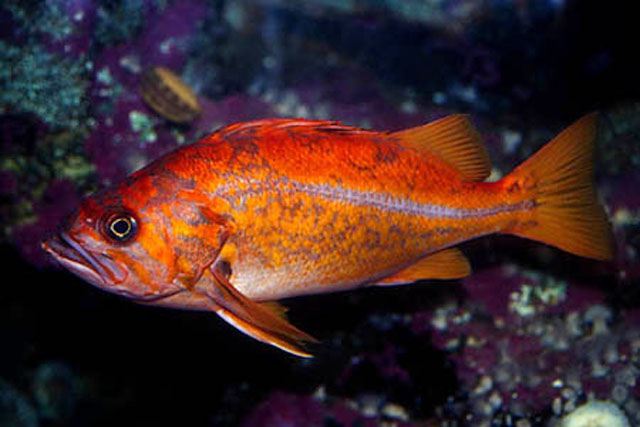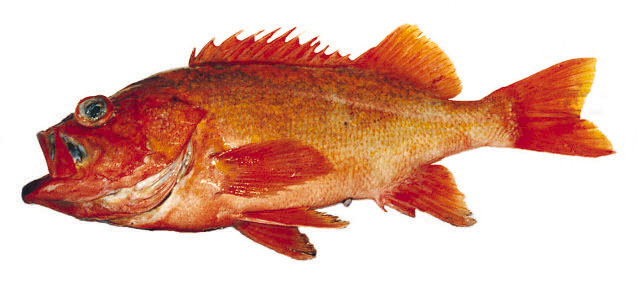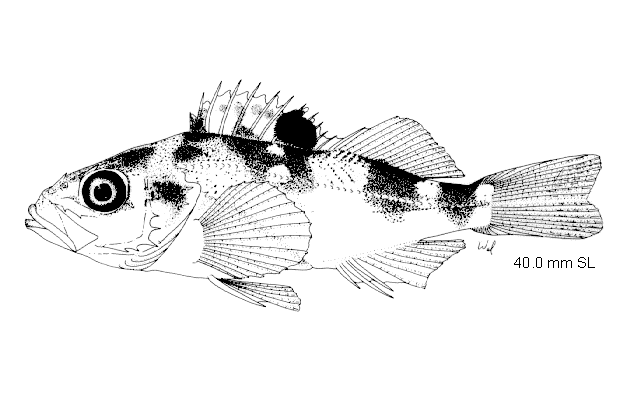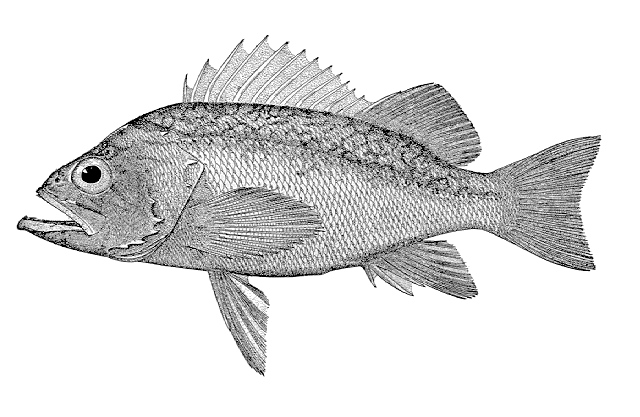Sebastes
pinniger
(Gill,
1864)
Canary rockfish
View all media / Upload your photos and videos
Expand all
Classification / Names
Teleostei (teleosts) > Perciformes/Scorpaenoidei (Scorpionfishes) >
Sebastidae (Rockfishes, rockcods and thornyheads)
> Sebastinae
Etymology: Sebastes: Greek, sebastes = august, venerable (Ref. 45335).
More on author:
Gill.
Environment / milieu / depth range / climate zone / distribution range
Distribution
Eastern Pacific: south of the Shelikof Strait in the Gulf of Alaska to Cape Colnett, Baja California, Mexico.
Maps

Sebastes pinniger / Native range
AquaMaps Data sources:
GBIF
OBIS
This map was computer-generated and has not yet been reviewed.

Sebastes pinniger / Suitable habitat
AquaMaps Data sources:
GBIF
OBIS
This map was computer-generated and has not yet been reviewed.

Sebastes pinniger / Point map
AquaMaps Data sources:
GBIF
OBIS
This map was computer-generated and has not yet been reviewed.

Sebastes pinniger / Year 2050
AquaMaps Data sources:
GBIF
OBIS
This map was computer-generated and has not yet been reviewed.
Length at first maturity / Size / Weight / Age
Short description
Dorsal spines (total): 13; Dorsal soft rays (total): 14 - 15; Anal spines: 3; Anal soft rays: 7. Head spines strong to moderate - nasal, preocular, supraocular, postocular, tympanic and parietal spines present, coronal and nuchal spines absent (Ref. 27437). Scales on lower jaw embedded; anal fin with a strong anterior slant (Ref. 27437). Caudal fin strongly indented (Ref. 6885). Bright yellow to orange mottled on a gray background; 3 orange stripes across head; fins orange; specimens less than 35.56 cm with dark markings on posterior part of spinous dorsal; gray along lateral line (Ref. 27437).
Biology
Adults hover in loose groups above rocky bottoms (Ref. 27436). Pelagic juveniles are found in shallower water (Ref. 27436). Feed on small fishes and krill (Ref. 2850). Viviparous, with planktonic larvae (Ref. 36715). Validated age by radiometry is 44 yrs (Ref. 49687). Flesh is of good quality (Ref. 27436). Sold as fillets (Ref. 27436).
Life cycle and mating behavior
Ovoviviparous (Ref. 6885).
Main reference
Eschmeyer, W.N., E.S. Herald and H. Hammann 1983 A field guide to Pacific coast fishes of North America. Boston (MA, USA): Houghton Mifflin Company. xii+336 p. (Ref. 2850)
IUCN Red List Status (Ref. 125652)
CITES (Ref. 131153)
Not Evaluated
CMS (Ref. 116361)
Not Evaluated
Threat to humans
Venomous (Ref. 4690)
More information
- Countries
- FAO areas
- Ecosystems
- Occurrences
- Introductions
- Stocks
- Ecology
- Diet
- Food items
- Food consumption
- Ration
- Common names
- Synonyms
- Metabolism
- Predators
- Ecotoxicology
- Reproduction
- Maturity
- Spawning
- Spawning aggregation
- Fecundity
- Eggs
- Egg development
- Age/Size
- Growth
- Length-weight
- Length-length
- Length-frequencies
- Morphometrics
- Morphology
- Larvae
- Larval dynamics
- Recruitment
- Abundance
- References
- Aquaculture
- Aquaculture profile
- Strains
- Genetics
- Allele frequencies
- Heritability
- Diseases
- Processing
- Mass conversion
- Vision
- Pictures
- Stamps, Coins Misc.
- Sounds
- Ciguatera
- Speed
- Swim. type
- Gill area
- Otoliths
- Brains
Estimates based on models
Preferred temperature (Ref. 123201): 4.7 - 8.3, mean 5.9 °C (based on 144 cells).
Phylogenetic diversity index (Ref. 82804): PD50 = 0.5 [Uniqueness, from 0.5 = low to 2.0 = high].
Bayesian length-weight: a=0.01000 (0.00495 - 0.02022), b=3.09 (2.92 - 3.26), in cm total length, based on LWR estimates for this Genus-body shape (Ref. 93245).
Trophic level (Ref. 69278): 3.8 ±0.6 se; Based on food items.
Resilience (Ref. 120179): Low, minimum population doubling time 4.5 - 14 years (tm=7; tmax=84; Musick et al. 2000 (Ref. 36717); Fec=85,000 (annual fecundity)).
Prior r = 0.20, 95% CL = 0.13 - 0.31, Based on 1 full stock assessment.
Fishing vulnerability (Ref. 59153): High vulnerability (62 of 100).
Climate vulnerability (Ref. 125649): Moderate to high vulnerability (45 of 100).
Price category (Ref. 80766): Low; Reliable: based on ex-vessel price for this species.
Nutrients (Ref. 124155): Calcium = 38.1 [11.8, 124.3] mg/100g; Iron = 0.661 [0.265, 1.673] mg/100g; Protein = 18.5 [17.3, 19.6] %; Omega3 = 0.751 [0.329, 1.720] g/100g; Selenium = 106 [39, 337] μg/100g; VitaminA = 15.7 [5.7, 45.8] μg/100g; Zinc = 0.427 [0.216, 0.811] mg/100g (wet weight); based on nutrient studies.





